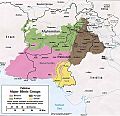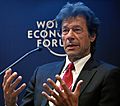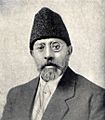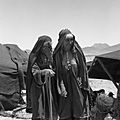Pashtun people facts for kids
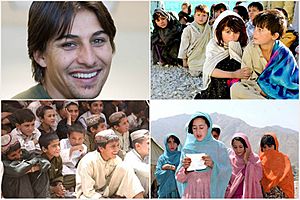
Pashtuns are a large group of people, also called Pushtuns, Pakhtuns, or Pukhtuns. They are the biggest ethnic group in Afghanistan. They are also the second largest in Pakistan. Their main language is Pashto. Many Pashtuns also speak Urdu, Hindko, and Dari. They originally come from the area south of the Hindu Kush mountains in Afghanistan. They also come from west of the Indus River in Pakistan. Today, many Pashtuns live in cities far from their traditional homes. Experts believe there are about 50 million Pashtuns in the world.
Contents
Pashtun History
Many Pashtuns believe their ancestors were ancient Hebrews. They think these ancestors came to what is now Afghanistan over 2,000 years ago. A Greek historian first wrote about them around 500 BC. Later, Alexander the Great also mentioned them. In the 3rd century, Persian rulers called them "Abgans" or "Afghans."
Thousands of Afghans served in the armies of the Ghaznavids and Ghurids. In the past, they ruled the Delhi Sultanate. They also ruled Persia from 1725 to 1729. After that, they created the last Afghan empire, which became modern Afghanistan.
Pashtun Code of Honor
The Pashtun people follow a strong code of honor called Pakhtunwali. This code guides their lives. It teaches them to help those who are poor, weak, or facing challenges. It also tells them to fight against bad things. Pakhtunwali means they must offer shelter to anyone who needs it.
Pashtuns also value obedience within their families and society. They are known for being very welcoming to guests. They take great care of visitors. They like to see respectful people with good manners in their communities.
What Pashtuns Do
Many Pashtuns are farmers, herdsmen, and warriors. A lot of them are also successful businessmen and politicians. Most people in the tribes are farmers. They grow crops and also raise animals. Some Pashtuns are nomadic herdsmen. This means they move with their animals. They also work as caravaners, moving goods from place to place. Many Pashtuns have always chosen to serve in the military.
Pashtuns in Afghanistan
About 50% of Afghanistan's population is Pashtun. They are divided into about 60 tribes. Each tribe has its own size and importance. Each tribe also lives in a different area. In Afghanistan, the main Pashtun tribes are the Durrani and the Ghilzai. The Durrani mostly live in the south and west of the country. The Ghilzai live in the northern and eastern parts.
Pashtuns in Pakistan
Pashtuns make up over 15% of Pakistan's population. Their main cities in Pakistan are Peshawar and Quetta. They are the main group north of Quetta, between the Sulaiman Range and the Indus River. Many Pashtuns also live in other big Pakistani cities. These include Karachi, Islamabad, Rawalpindi, and Lahore.
In the hill areas of Pakistan, there are many tribes. From south to north, these include the Tarin, Kakaṛ, Sherani, and Ustarana tribes. These live south of the Gumal River. Between the Gumal River and Thal are the Maḥsud, Darwesh Khel, Waziri, and Biṭani tribes. From Thal to the Khyber Pass, you find the Turi, Bangash, Orakzay, Afridi, and Shinwari tribes. To the north and northeast of the Khyber are the Mahmand, Utman Khel, Tarklani, and Yusufzay tribes.
Images for kids
-
Tents of Afghan nomads in Badghis Province who are known in Pashto language as Kuchian. They migrate from region to region depending on the season (transhumance).
-
Pactyans, present day Pashtunistan. The Oriental Empires about 600 B.C., Historical Atlas by William Shepherd (1923-26)
-
Heads of two males, discovered in Hadda (Pashto: هډه) 10km south of Jalalabad, Afghanistan. Dated 3-4th century CE.
-
Afghan Amir Sher Ali Khan (in the center with his son) and his delegation in Ambala, near Lahore, in 1869
-
Leader of the non-violent Khudai Khidmatgar, also referred to as "the Red shirts" movement, Bacha Khan, standing with Mohandas Gandhi
-
Malala Yousafzai, a Pashtana, recipient of 2014 Nobel Peace Prize
-
American diplomat Zalmay Khalilzad with Taliban officials Abdul Ghani Baradar, Abdul Hakim Ishaqzai, Sher Mohammad Abbas Stanikzai and Suhail Shaheen
-
President Hamid Karzai and Abdul Rahim Wardak
-
From left to right: Ashraf Ghani Ahmadzai; Anwar ul-Haq Ahady; and Abdullah Abdullah
-
Imran Khan, Pakistani cricketer-turned-politician and former Prime Minister, belongs to the Niazi tribe.
-
Khattak dance involves running and whirling. It is mainly performed in and around the Peshawar area of Pakistan.
-
Mahmud Tarzi, son of Ghulam Muhammad Tarzi, became the pioneer of Afghan journalism for publishing the first newspaper Seraj al Akhbar.
-
Arachosian priests of Zoroastrianism carrying various gifts and animals for a ritual of sacrifice at Persepolis.
-
The Friday Mosque in Kandahar. Adjacent to it is the Shrine of the Cloak(also known as Kirka Sharif), and the tomb of Ahmad Shah Durrani, the 18th century Pashtun conqueror who became the founding father of Afghanistan.
-
Men doing Islamic salat (praying) outside in the open in the Kunar Province of Afghanistan
-
Two Pashtane (Pashtun women) from Kuchi tribe pictured in 1967 on the Helmand river (د هلمند سيند)
-
Malala Yousafzai, Pakistani activist for female education and the 2014 Nobel Peace Prize laureate
-
Zarine Khan, Indian model and actress in Bollywood films
-
Madhubala, Indian Bollywood actress and producer
See also
 In Spanish: Pueblo pastún para niños
In Spanish: Pueblo pastún para niños


